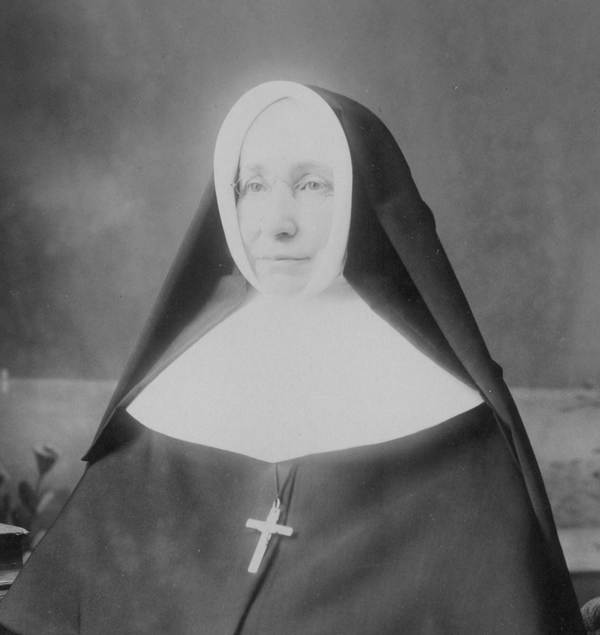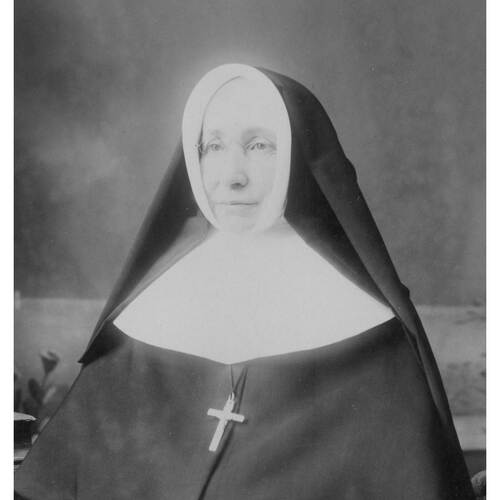
Source: Link
BUISSON, EDWIGE (Hedwige, Hedwidge), named Saint-Joseph, teacher, and a founder and superior of the Sisters of the Assumption of the Blessed Virgin Mary; b. 4 Sept. 1837 on the outskirts of Trois-Rivières, Lower Canada, fourth of the ten children of Antoine Buisson, a farmer, and Émilie Blondin; d. 7 Nov. 1902 in Nicolet, Que.
Edwige Buisson grew up in exemplary family surroundings. Her parents, who were quite well-educated for the time, were devout Christians. More by example than by words, her mother instilled in her a love of duty, a spirit of generosity, and a habitual moral vigour, charity, and kindness. Edwige must have been very young when she began to attend the school for girls located near her father’s house in the village of Saint-Grégoire (Bécancour), to which the Buissons had moved a few years after she was born. At the age of 15 she completed the courses at the model school in the village. Although she was not old enough to obtain a teaching certificate, she passed the aptitude examination given by the district inspector, and he put her in charge of a class at the École Saint-Henri in the parish. Attracted to the religious life, she visited various congregations at Trois-Rivières and Montreal during her holidays in 1852. Although these visits aroused in her an admiration of which she made no secret, she remained convinced she was not called by God to any of these institutions. In the fall, by her own testimony, she told her confessor Abbé Calixte Marquis about her aspirations and he said that “he wanted to found a new community in cooperation with the Rev. Mr [Jean] Harper, and that I could be admitted as one of its first members.”
In the spring of 1853 Edwige informed her parents of this plan. Although they considered her very young to make such a serious decision, in the end they gave their consent, on condition that Father Harper head the new institution. The parents of young candidates seemed to have less confidence in the curate, Abbé Marquis, for a project of such magnitude.
On 8 Sept. 1853 Edwige and three companions, Léocadie Bourgeois, Mathilde Leduc, and Julie Héon, gathered at the Maison Desforges, a model school bought by the parish fabrique as a home for the future nuns. Seven days later the establishment opened as a boarding-school for girls, with about 50 students. Edwige was responsible for teaching the senior grades and looking after the students in everyday matters. On 17 Aug. 1856 she and her companions took their vows of religious profession before the bishop of the diocese, Thomas Cooke*, who then gave canonical recognition to the little community under the name of Sisters of the Assumption of the Blessed Virgin Mary. Seven years later Sister Saint-Joseph made her permanent commitment to the congregation, adding to the specific vows made at the time of her consecration the vow of dedicating herself to the education of the young.
Sister Saint-Joseph was elected superior of the congregation the following year, for a period that was to last for six years. No sooner had she taken office than the curé of Baie-du-Febvre requested some nuns for the convent he wanted to establish in his parish. This first scattering of the community was difficult, but because she wanted to see large numbers of youth enjoy the benefits of a thoroughly Christian education, she agreed to this second centre of learning. Four nuns from the congregation, which had 20 members in August 1865, began teaching at Baie-du-Febvre in September. Despite the interest that Mother Saint-Joseph was to take in the internal administration of the congregation, she never lost sight of the importance of extending the work she had undertaken. She presented a request to the civil authorities to have the institute incorporated, which was granted on 18 Sept. 1865.
During her second term as superior, from 1873 to 1879, Mother Saint-Joseph sought to allay the tensions created by the transfer of the mother house from Saint-Grégoire to Nicolet on 12 Sept. 1872. The parishioners of Saint-Grégoire had been fiercely opposed to having the community’s principal house located in Nicolet, since it had been founded by four of their fellow citizens. However, because of the need to provide spiritual guidance for the growing number of members, the bishop had authorized the removal of the congregation’s main centre to the vicinity of the Séminaire de Nicolet. The “Gregorians” finally reconciled themselves to the change, but only after being assured that the founding house would remain in their village as an educational institution.
Mother Saint-Joseph held the office of superior again from 1882 to 1888 and from 1891 to 1900. Shortly after her election in 1891, at the request of Bishop Vital-Justin Grandin of the diocese of St Albert, three nuns went to help the Oblates of Mary Immaculate among the Cree at Lac d’Oignon (Onion Lake, Sask.). Those who had been chosen left for their new mission field on 26 August. On the same day another contingent of seven nuns set out for the United States, heading for Southbridge, Mass. In agreeing to this foundation, the superior involved the congregation in a new approach to its apostolic calling. American parochial schools were neither twinned with a boarding-school nor linked to a public system of education, but were responsible solely to the parish. From that time also, the nuns began teaching boys as well as girls.
The needs of the missionaries who were far from the mother house were of special concern to Mother Saint-Joseph. She not only wrote to them, but she also went in person to encourage them in their difficult task and find out how to improve their living conditions. In 1892 she went to the Canadian northwest and to the United States. She would make two more journeys to visit indigenous people, in 1895 and in 1898.
Mother Saint-Joseph accomplished a great deal, particularly in her last term of office; she devoted herself to completing the work of organizing and consolidating the institution, tasks in which she had always been engaged. In 1900 the congregation was given new constitutions. In addition, since with the growing numbers of sisters there was a shortage of space in the mother house, she had an extension built, in which was to be erected a magnificent structure known as the golden jubilee chapel. However, she would not live to see the completion of the new sanctuary or the jubilee celebrations of 1903. After leading her community for 27 years, she died on 7 Nov. 1902.
A modest and distinguished woman, sure in her judgement, Mother Saint-Joseph is remembered as a nun of remarkable psychological and moral balance. Generous and persevering, she had applied herself enthusiastically to her teaching duties and had made every effort to broaden her knowledge. She was well known for her kindness; she could also, when necessary, show an unshakeable strength of will. Once she was convinced, after much thought and prayer, that a cause was worth defending or a goal worth achieving, she acted on her convictions gently but firmly.
In 1900, when Mother Saint-Joseph’s last term of office ended, the congregation had 247 nuns and 28 educational institutions, with four in the Canadian northwest and four in the United States. On the solemn occasion of the golden jubilee in 1903, the community acknowledged publicly that it owed its rapid growth and development to the “gentle and firm hand” of Edwige Buisson, who is rightly considered the “mother of the congregation.”
ANQ-MBF, CE1-48, 4 sept. 1837. Arch. des Sœurs de l’Assomption de la Sainte Vierge (Nicolet, Qué.), Chroniques de Saint-Grégoire, 1853–1916; Chroniques de sœur Sainte-Élisabeth, 1831–1905; Manuscrit de vénérée mère Saint-Joseph, 15 août 1902; Louise Mathieu, “Mère Saint-Joseph, son esprit, sa survie dans la congrégation” (mimeograph, Nicolet, 1977); Reg., décrets, visites, des Sœurs de l’Assomption de la Sainte Vierge, Saint-Célestin, 1868–1959, 7 avril 1874; Reg.A, actes authentiques des Sœurs de l’Assomption de la Sainte Vierge, 2: f.1; Reg.H, personnel, 1, élections; Reg. des délibérations des commissaires d’école de la paroisse Saint-Grégoire-le-Grand, 20, 26 juin, 16 juill. 1852; Reg. des offices du personnel de la communauté des Sœurs de l’Assomption de la Sainte Vierge, 1: 4; Sœur Sainte-Élisabeth [Élia Blanchette], Vie intime de regrettée mère Saint-Joseph, 4 mai 1910. M.-R. Gravel, “Hommage à nos fondatrices,” Sœurs de l’Assomption de la Sainte Vierge, Service d’Information et de Documentation, Bull. (Nicolet), 8 (1983): 128–45. Germain Lesage, Les origines des Sœurs de l’Assomption de la Sainte Vierge (Nicolet, 1957); Le transfert à Nicolet des Sœurs de l’Assomption de la Sainte-Vierge, 1858–1874 (Nicolet, 1965). Alice Mignault, Sous les feux du cinquantenaire chez les Sœurs de l’Assomption de la Sainte Vierge, 1895–1916 (Nicolet, 1990); Vingt ans d’expansion chez les Sœurs de l’Assomption de la Sainte Vierge, 1874–1894 (Nicolet, 1985). [Élodia Plamondon, dite Saint-Casimir], Mère Saint-Joseph, de la congrégation des Sœurs de l’Assomption de la S. V. (Nicolet, 1916); “Une mère et un modèle,” École Normale de Nicolet, Annuaire (Joliette, Qué), 1925–26: 1–11.
Revisions based on:
Ancestry.com, “Quebec, Canada, vital and church records (Drouin collection), 1621–1968,” Mère Saint Joseph, 11 nov. 1902: www.ancestry.ca (consulted 2 June 2021). Bibliothèque et Arch. Nationales du Québec, Centre d’arch. de la Mauricie et du Centre-du-Québec (Trois-Rivières, Québec), CE401-S48, 1er mai 1832.
Cite This Article
Mariette Pellerin, “BUISSON, EDWIGE (Hedwige, Hedwidge), named Saint-Joseph,” in Dictionary of Canadian Biography, vol. 13, University of Toronto/Université Laval, 2003–, accessed December 31, 2025, https://www.biographi.ca/en/bio/buisson_edwige_13E.html.
The citation above shows the format for footnotes and endnotes according to the Chicago manual of style (16th edition). Information to be used in other citation formats:
| Permalink: | https://www.biographi.ca/en/bio/buisson_edwige_13E.html |
| Author of Article: | Mariette Pellerin |
| Title of Article: | BUISSON, EDWIGE (Hedwige, Hedwidge), named Saint-Joseph |
| Publication Name: | Dictionary of Canadian Biography, vol. 13 |
| Publisher: | University of Toronto/Université Laval |
| Year of publication: | 1994 |
| Year of revision: | 2022 |
| Access Date: | December 31, 2025 |



